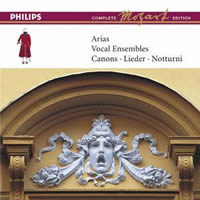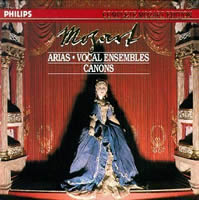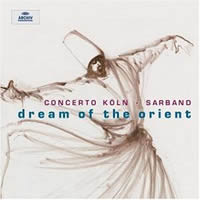WAM: Crude and Cosmopolitan
|
Ethelbert “Amadeus” Nevin [April 2006.]
The eighth disc of the 10-CD Volume 12 in Philips’ complete edition of Salzburg’s favorite son (Philips 00289 464 8802) offers a rag-tag of canons (on its first release, Philips 422 523-2, it was the last CD of the 8-disc Volume 23). Some mayn’t be Mozart’s, most probably are. Regardless, they’ve retained their place in the man’s oeuvre even if a footnote or zealous scholar might reasonably redirect them toward the circular file. One canon features the exquisite text “Leck mich im Arsch” (KV 231 / 382c). In six parts, KV 231 rings rather prettily. Apart from the opening line, I can hear a children’s choir…. Its companion, KV 233 / 382d, “Leck mir den Arsch fein recht schön sauber,” appears with the altogether tastier words “Nichts labt mich mehr als Wein.” Another canon, KV 561, contains “Scheiß ins Bett, daß’ kracht / Gute Nacht, schlaf fein g’sund / Und reck den Arsch zum Mund.” Can these really be Mozart’s, that illustrious son, that selfsame genius who brought us the Elvira Madigan Piano Concerto? Scholars with a great deal of free time have debated the issue. Maybe the canons are real, and maybe the words aren’t. Maybe they’re spurious, an attempt to besmirch. Thanks to Peter Shaffer, we like to think of Wolfie as an immature prick who sought paternal approval in vain. Be that as it may, let’s do try to come up with composers whose reputation would thus survive off-color stuff. Brahms collected nudie postcards? Rubbish. Elgar savored fart jokes? Unthinkable. Rimsky-Korsakov swore like a boswain? Nah. Ives stashed Tijuana Bibles? Of course not. But Mozart could write dirty canons. Sure. Whatever.
Like any freelance musician, Vienna’s favorite son had to dress fashionably and keep up with trends. After the siege of Vienna ended in 1683 and the Ottomans split the scene, Turkish influence expressed itself across Europe as an exotic attraction, and WAM, no fool he, picked up on the vibes. Several A-major works (a violin concerto and a piano sonata) mimic Turkish effects: triangle, crescent, cymbals, drums. “Dream of the Orient” (Archiv 474 193-2) delightfully mingles 17th- and 18th-century classical and Turkish music, members of Concerto Köln under Werner Ehrhardt playing alongside Vladimir Ivanoff’s Sarband. Mozart, Gluck, J.M. Kraus and Süssmayr alternate with period Turkish music. (Aha! A chance to hear something of Süssmayr’s besides the Requiem!) Sarband’s percussion added to Mozart’s Overture from The Abduction from the Seraglio provides an uncommonly lively burst and rattle. The fast-paced Turkish pieces with their bright rhythms and beguiling scales are most enjoyable. Reconstructed from a 1787 Venetian manuscript, the Concerto turco nominato “Izia semaisi” (Turkish concerto in the hijaz scale) has the ensembles performing jointly. Tatar Han Gazi Giray’s Mahur pesrevi (Janissaries’ March) is especially bewitching. I love hearing violins playing these scales.
[More Ethelbert Nevin]
[More
Mozart]
[Previous Article:
’Philespeak]
[Next Article:
Denhoff, Grisey, Neuwirth]
|


